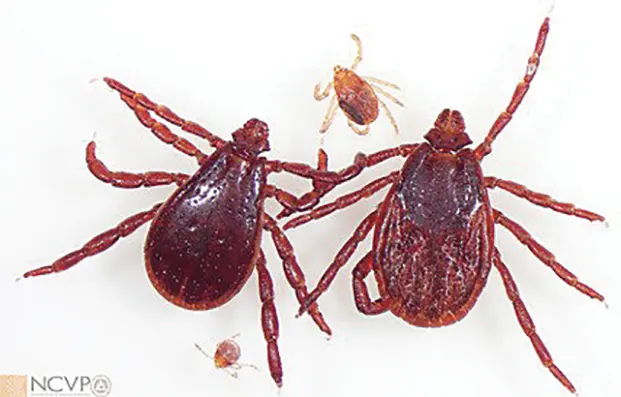Brown Dog Ticks Increasingly Difficult to Control with Traditional Approaches
In the Literature
Rodriguez-Vivas RI, Ojeda-Chi MM, Trinidad-Martinez I, Pérez de León AA. First documentation of ivermectin resistance in Rhipicephalus sanguineous sensu lato (Acari: Ixodidae). Vet Parasitol. 2017;233:9-13.
The Research …
Acaricidal resistance in brown dog ticks is a growing concern. Although ivermectin is not label-approved or commonly recommended for the control of brown dog ticks, it is used in some countries for this purpose. Recent data indicate that this approach is not effective against some populations of brown dog ticks in Mexico.1

Clockwise from top. Nymph, adult female, larva, and adult male of Rhipicephalus sanguineus sensu lato, the brown dog tick. Brown dog ticks have recently been shown to be a species complex comprising several morphologically similar but genetically distinct tick species. The different populations have not been found together and do not appear to breed and produce viable offspring. Image courtesy of the National Center for Veterinary Parasitology

Engorged female ticks on ground outside infested home with several dogs. Each female will deposit a clutch of approximately 4000 eggs; larvae hatch a few weeks later to begin the life cycle anew.
In this study, engorged female brown dog ticks (Rhipicephalus sanguineus sensu lato) were collected from 15 populations of dogs in 6 cities in Yucatan, Mexico. The female ticks were allowed to oviposit, and the hatched larvae were used in resistance bioassays with technical-grade ivermectin. The authors reported that a significantly higher concentration of ivermectin was required to kill the larvae in 10 of the 15 tick populations as compared with susceptible controls.1
The researchers also collected information from the dogs’ owners about use of ivermectin and conventional acaricides in the past 5 years and showed widespread use of a number of different tick-control products, including amitraz, coumaphos, cypermethrin, and fipronil in addition to ivermectin. Occasional failure of these and other products to control brown dog ticks has been previously documented.2-4
Although the identity of the ticks in this study did not appear to be molecularly confirmed, based on average temperatures in Yucatan, they were most likely the tropical lineage of Rhipicephalus sanguineus sensu lato. To date, reports of resistance in brown dog ticks are from tropical regions, including Panama, Florida (United States), and Mexico.2-4 Further research is needed to determine if resistance poses similar concerns for the temperate lineage of Rhipicephalus spp found in most of the United States and Europe.5,6 Integrated tick management and consistent use of effective acaricides are necessary to control home and kennel infestations with brown dog ticks.
… The Takeaways
Key pearls to put into practice:
Home brown dog tick infestations can be difficult to eradicate and require long-term use of effective acaricides.
A number of different traditional acaricides are available for dogs but may vary widely in efficacy even within a given tick population.
Consistent, year-round use of label-approved, effective acaricides is the best strategy to limit tick infestations in homes and kennels.